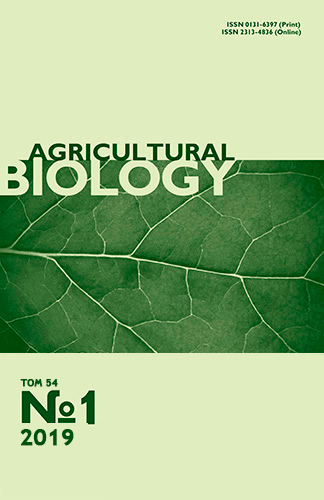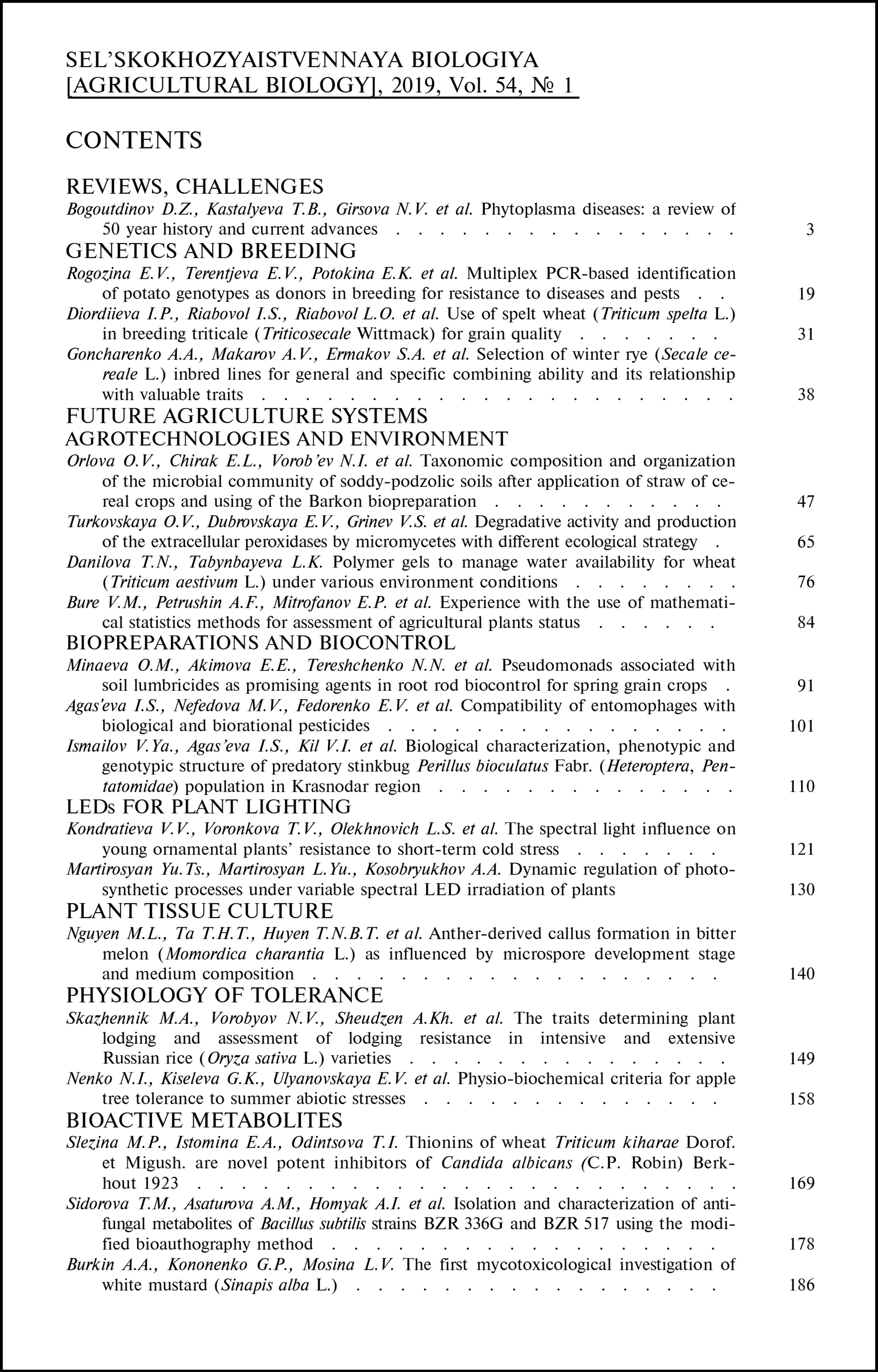doi: 10.15389/agrobiology.2019.1.140eng
UDC 635.6:576.3/.7.086.83:58
Acknowledgements:
Funded by Da Nang University Science and Technology Development Foundation by project No. B2017-DN03-13
ANTHER-DERIVED CALLUS FORMATION IN BITTER MELON
(Momordica charantia L.) AS INFLUENCED BY MICROSPORE DEVELOPMENT STAGE AND MEDIUM COMPOSITION
M.L. Nguyen1, T.H.T. Ta1, T.N.B.T. Huyen1, A.V. Voronina2
1University of Education — The University of Da Nang, Vietnam, Danang city, 459 — Ton Duc Thang st., e-mail nmly@ued.udn.vn (✉ corresponding author), tienhuyentonnubao@gmail.com, thaotth88@gmail.com;
2Timiryazev Russian State Agrarian University—Moscow Agrarian Academy, 49, ul. Timiryazevskaya, Moscow, 127550 Russia, e-mail chistovan@mail.ru
ORCID:
Nguyen M.L. orcid.org/0000-0002-0652-891X
Huyen T.N.B.T. orcid.org/0000-0003-0467-9391
Ta T.H.T. orcid.org/0000-0002-0652-4601
Voronina A.V. orcid.org/0000-0003-0249-246X
Received November 4, 2018
Anther culture is one of the powerful techniques to pure line production for the short time. This method can be applied to accelerate the breeding process of F1 hybrids of bitter melon (Momordica charantia L., family Cucurbitaceae), which is an important commercial crop in tropical and subtropical countries of South America, Asia and Africa. Although, there are several factors affecting the success of this method, the effective protocol of bitter melon anther culture has not been developed at present. The results of this study showed that the microspore developmental stage has a significant (p ≤ 0.05) effect on speed and rate of callus formation. It was revealed that the frequency and the rate of callus formation and the morphology of callus substantially depend on the composition and concentration of growth regulators in the nutrient medium. In addition, the dynamics of callus formation in bitter melon anther culture was first studied. The main objective of the work was to study the influence of the microspore developmental stage and the composition of nutrient medium on the ability of callus formation in bitter melon anther culture in vitro. Plants of the F1 hybrid bitter melon Diago 26 were grown in field in Dailoc district, Quangnam province (Vietnam) in 2018 according to the standard technique for obtaining commercial fruits. The buds harvested at 5-7 am were stored in plastic bags in dark condition at 4 °С for 1 day. Before culturing of anther, flower buds were surfaced sterilized using 70 % ethanol and 5 % sodium hypochlorite (NaOCl). Anther removed from flower buds were inoculated in the induction medium in the horizontal laminar air flow; then incubated at 25±2 °С and a photoperiod of 16 h light/8 h dark for 4 weeks. Three variants of the Murashige-Skoog (MS) nutrient mediums were used, differing in composition and concentration of growth regulators: MK1 with the addition of 1.0 mg/l 2.4-D and 1.5 mg/l BAP; MK2 — 1.5 mg/l 2,4-D and 1.0 mg/l BAP; MK3 — 1.5 mg/l NAA, 1.0 mg/l BAP and 0.5 mg/l kinetin. The completely randomized design with statistical analysis using the software IBM SPSS Statistics Base 22 and Microsoft Excel 2013 were carried out. The cytological analysis result showed that each anther contained microspores with different development stages. Therefore, it is impossible to separate microspores at the unique developmental stage being suitable for anther culture; however, there is always a predominant stage. In this study, buds were divided into two main groups. The first group consisted of buds with the size of 4.0-5.0 mm with early and mid uninucleate microspores. The second group included buds with the size of 5.1-6.5 mm with late uninucleate and binucleate microspore. After inoculation, the beginning of calli formation was observed within the first week for anther of the buds with the size of 4.0-5.0 mm and within the second week for the buds with the size of 5.1-6.5 mm. The highest frequency of callus formation (93.75±2.55 %) was observed on MS medium supplemented with 1.0 mg/l of 2,4-D and 1.5 mg/l of BAP (MK1). Most calli were formed during the second and third week after cultivation. Also, there was the significant difference about the morphology of the calli obtained on three nutrient medium. Calli on medium MK1 were yellow, strongly dense and calli on MS medium with the addition of 1.5 mg/l of 2,4-D and 1,0 mg/l of BAP (MK2) being green, strongly dense. Green-yellow, dense calli were obtained on medium supplemented with 1.5 mg/l NAA and 1.0 mg/l BAP and 0.5 mg/l Kinetin (MK3). However, the effect of the developmental stage of microspores on the morphology of calli was not revealed. Despite receiving a large number of calli, the formation of embryoids was not observed.
Keywords: Momordica charantia L., bitter melon, callus, doubled haploid, anther culture,microspore stage.
REFERENCES
- Gupta M., Sharma S., Gautam A.K., Bhadauria R. Momordica charantia Linn. (Karala): nature’s silent healer. International Journal of Pharmaceutical Sciences Review and Research, 2011, 11(1): 32-37.
- Ahmad N., Hasan N., Ahmad Z., Zishan M., Zohrameena S. Momordica Charantia: For traditional uses and Pharmacological actions. Journal of Drug Delivery & Therapeutics, 2016, 6(2): 40-44 CrossRef
- Le M.L., Trieu P.T., Huynh L.A.N. Shoot regeneration from cotyledonary sections of Momordica charantia L. in vitro. Science Journal of Can Tho University, 37(2): 47-54.
- Reyes R.M. Current status of bitter gourd production and marketing in Asia and market potential of bitter gourd as a functional vegetable. International Bitter Gourd Conference. Hyderadad, India, 2014. Available https://docplayer.net/36306338-Current-status-of-bitter-gourd-production-and-marketing-in-asia-and-market-potential-of-bitter-gourd-as-a-functional-vegetable.html. Accessed February 28, 2019.
- Arafat S.Y., Nayeem M., Jahan S., Karim Z., Reza H.M., Hossain M.H., Shohel M., Alam M.A. Ellagic acid rich Momordica charantia fruit pulp supplementation prevented oxidative stress, fibrosis and inflammation in liver of alloxan induced diabetic rats. Orient. Pharm. Exp. Med., 2016, 16(4): 267-278 CrossRef
- Joseph B., Jini D. Antidiabetic effects of Momordica charantia (bitter melon) and its medicinal potency. Asian Pac. J. Trop. Dis., 2013, 3(2): 93-102 CrossRef
- Poolperm S., Jiraungkoorskul W. An update review on the anthelmintic activity of bitter gourd, Momordica charantia. Phcog. Rev.,2017, 11(21): 31-34 CrossRef
- Behera T.K., Behera S., Bharathi L.K., John K.J., Simon P.W., Staub J.E. Bitter gourd: botany, horticulture breeding. Horticultural Reviews, 2010, 37: 101-141 CrossRef
- Bal U., Shariatpanahi M.E., Castro A.J., Emery D., Clemente C., Dehestani-Ardakani M., Mozaffari K., Touraev A. Pseudo-embryogenic structures in anther and isolated microspore cultures in vitro: a cautionary guide. Czech J. Genet. Plant Breed., 2012 48(2): 51-60 CrossRef
- Monakhos S.G., Nguen M.L., Bezbozhnaya A.V., Monakhos G.F. A relationship between ploidy level and the number of chloroplasts in stomatal guard cells in diploid and amphidiploid Brassica species. Sel’skokhozyaistvennaya Biologiya [Agricultural Biology], 2014, 5: 44-54 CrossRef (in Engl.).
- Usman M., Bakhsh K., Fatima B., Zaman Q., Shah M.H. Exploring embryogenic competence in anthers of Bitter gourd (Momordica charantia L.) cultivar Faisalabad long. The Journal of Animal & Plant Sciences, 2015, 25(1): 181-188.
- Kumar H.G.A., Murthy H.N., Paek K.Y. Embryogenesis and plant regeneration from anther cultures of Cucumis sativus L. Scientia Horticulturae, 2003, 98: 213-222 CrossRef
- Ren J., Wu P., Trampe B., Tian X., Lubberstedt T., Chen S. Novel technologies in doubled haploid line development. Plant Biotechnol. J., 2017, 15(11): 1361-1370 CrossRef
- Forster B.P., Heberle-Bors E., Kasha K.J., Touraev A. The resurgence of haploids in higher plants. Trends Plant Sci., 2007, 12(8): 368-375 CrossRef
- Dwivedi S.L., Britt A.B., Tripathi L., Sharma S., Upadhyaya H.D., Ortiz R. Haploids: constraints and opportunities in plant breeding. Biotechnol. Adv., 2015, 33(6): 812-829 CrossRef
- Qiao G.,Li H., Liu M.,Jiang J., Yin Y., Zhang L., Zhuo R. Callus induction and plant regeneration from anthers of Dendrocalamus latiflorus Munro. In Vitro Cell. Dev. – Pl., 2013, 49(4): 375-385 CrossRef
- Pivovarov V.F., Bondareva L.L., Shmykova N.A., Shumilina D.V., Mineikina A.I. New generation hybrids of white cabbage (Brassica oleracea L. convar. capitata var. alba DC) based on doubled haploids.Agricultural Biology, 2017, 52(1): 143-151 CrossRef (in Engl.).
- Tang Y., Li H., Liu J., Liu B., Lio H.P. Callus formation from anther culture in Balsam Pear (Momordica charantia L.). American-Eurasian J. Agric. & Environ. Sci., 2009, 6(3): 308-312.
- Tang Y., Liu J., Liu B., Li J., Li X.M., Li H.X. Effect of different treatment on anther callus formation and browning in Balsam pear (Momordica charantia L.). J. Agric. Sci. Technol., 2010, 4(6): 53-56.
- Tang Y., Liu J., Liu B., Li X.M., Li J., Li H.X. Endogenous hormone concentrations in explant and calluses of Bitter Melon (Momordica charantia L.). Interciencia, 2010, 35(9): 680-683.
- Pukhal'skii V.A., Solov'ev A.A., Badaeva E.D., Yurtsev V.N. Praktikum po tsitologii i tsitogenetike rastenii [Workshop on plant cytology and cytogenetics]. Moscow, 2007 (in Russ.).
- Blackmore S., Wortley A.H., Skvarla J.J., Rowley J.R. Pollen wall development in flowering plants. New Phytol., 2017, 174(3): 483-498 CrossRef
- Dunwell M.J. Haploids in flowering plant: origins and exploitation. Plant Biotechnol. J., 2010, 8: 377-424 CrossRef
- Germana M.A. Anther culture for haploid and doubled haploid production. Plant Cell Tiss. Org., 2011, 104(3): 283-300 CrossRef
- Adhikari P.B., Kang W.H. Association of floral bud and anther size with microspore developmental stage in Campari tomato. Wonye kwahak kisulchi = Korean journal of horticultural science and technology, 2017, 35(5): 608-617 CrossRef
- Zhang C., Tsukuni T., Ikeda M., Sato M., Okada H., Ohashi Y., Matsuno H., Yamamoto T., Wada M., Yoshikawa N., Matsumoto S., Li J., Mimida N., Watanabe M., Suzuki A., Komori S. Effects of the microspore development stage and cold pre-treatment of flower buds on embryo induction in apple (Malus ½ domestica Borkh.) anther culture. Journal of the Japanese Society for Horticultural Science, 2013, 82(2): 114-124 CrossRef
- Ibrahim A.M., Kayat F.B., Hussin Z.E.S.M., Susanto D., Ariffulah M. Determination of suitable microspore stage and callus induction from anthers of kenaf (Hibiscus cannabinus L.). The Scientifc World Journal, 2014, 2014: Article ID 284342 CrossRef
- Shmykova N.A., Shumilina D.V., Suprunova T.P. Doubled haploid production in Brassica L. species. Russian Journal of Genetics: Applied Research, 2016, 6(1): 68-77 CrossRef
- Gałązka J., Niemirowicz-Szczytt K. Review of research in haploid production in cucumber and other curcubits. Folia Horticulturae, 2013, 25(1): 67-78 CrossRef
- Kumar H.G.A., Murthy H.N. Effect of sugars and amino acids on androgenesis of Cucumis sativus. Plant Cell Tiss. Org.,2004, 78(3):201-208 CrossRef
- Song H., Lou Q., Luo X., Wolukau J.N., Diao W., Qian C., Chen J. Regeneration of doubled haploid plants by androgenesis of cucumber (Cucumis sativus L.). Plant Cell Tiss. Org., 2007, 90: 245-254 CrossRef
- Assani A., Bakry F., Kerbellec F., Haicour R., Wenzel G., Foroughi-Wehr B. Production of haploids from anther culture of banana [Musa balbisiana (BB)]. Plant Cell Rep., 2003, 21: 511-516 CrossRef












